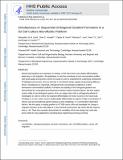Simultaneous or Sequential Orthogonal Gradient Formation in a 3D Cell Culture Microfluidic Platform
Author(s)
Uzel, Sebastien GM; Amadi, Ovid C; Pearl, Taylor M.; Lee, Richard T; So, Peter T. C.; Kamm, Roger Dale; ... Show more Show less
DownloadKamm_Simultaneous or.pdf (1.802Mb)
OPEN_ACCESS_POLICY
Open Access Policy
Creative Commons Attribution-Noncommercial-Share Alike
Terms of use
Metadata
Show full item recordAbstract
Biochemical gradients are ubiquitous in biology. At the tissue level, they dictate differentiation patterning or cell migration. Recapitulating in vitro the complexity of such concentration profiles with great spatial and dynamic control is crucial in order to understand the underlying mechanisms of biological phenomena. Here, a microfluidic design capable of generating diffusion-driven, simultaneous or sequential, orthogonal linear concentration gradients in a 3D cell-embedded scaffold is described. Formation and stability of the orthogonal gradients are demonstrated by computational and fluorescent dextran-based characterizations. Then, system utility is explored in two biological systems. First, stem cells are subjected to orthogonal gradients of morphogens in order to mimic the localized differentiation of motor neurons in the neural tube. Similarly to in vivo, motor neurons preferentially differentiate in regions of high concentration of retinoic acid and smoothened agonist (acting as sonic hedgehog), in a concentration-dependent fashion. Then, a rotating gradient is applied to HT1080 cancer cells and the change in migration direction is investigated as the cells adapt to a new chemical environment. The response time of ≈4 h is reported. These two examples demonstrate the versatility of this new design that can also prove useful in many applications including tissue engineering and drug screening.
Date issued
2015-11Department
Harvard University--MIT Division of Health Sciences and Technology; Massachusetts Institute of Technology. Department of Biological Engineering; Massachusetts Institute of Technology. Department of Mechanical Engineering; Sloan School of ManagementJournal
Small
Publisher
Wiley Blackwell
Citation
Uzel, Sebastien G. M., Ovid C. Amadi, Taylor M. Pearl, Richard T. Lee, Peter T. C. So, and Roger D. Kamm. “Simultaneous or Sequential Orthogonal Gradient Formation in a 3D Cell Culture Microfluidic Platform.” Small 12, no. 5 (November 30, 2015): 612–622.
Version: Author's final manuscript
ISSN
16136810